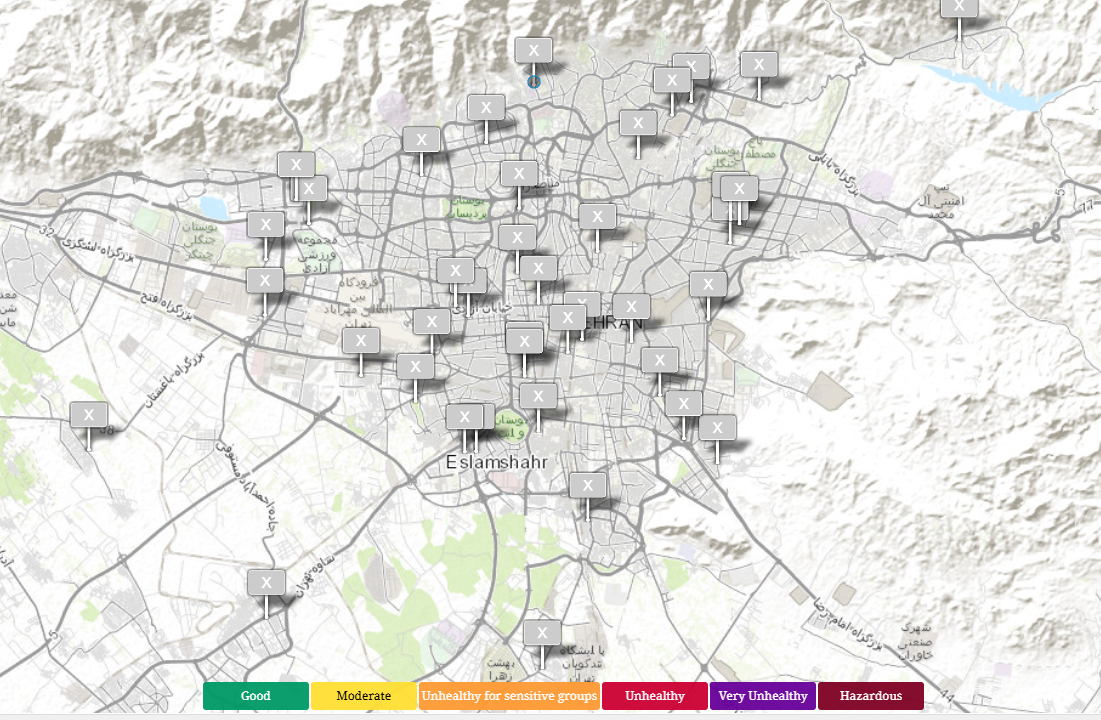Air pollution in Tehran reached hazardous levels on November 23, prompting authorities to move schools online and implement emergency measures across the province, Newsbase has learnt.
Tehran's chronic air pollution stems from a combination of geographic and industrial factors, with the city's location in a valley surrounded by mountains creating an atmospheric inversion effect that traps pollutants close to ground level due to cold weather. During winter months, the inversion layer intensifies as cold air becomes trapped beneath warmer air above, preventing pollutants from dispersing and creating hazardous conditions.
Monitoring at the Royal Danish Embassy in northern Tehran on November 23 showed a US Air Quality Index reading of 189 at 1:30pm local time, with PM2.5 levels of 109 microgrammes per cubic metre, categorising conditions as "unhealthy." Earlier reports from the embassy monitoring stations showed a peak of more than 220 PM2.5 levels on November 22.
Online social media in Iran has become increasingly critical of government pollution readings, fearing that monitoring stations have been either switched off or producing metered-down readings.
According to the Iran National Air Quality Monitoring System represented on another website, all government monitoring stations in the capital city appear to have been turned off or are malfunctioning, IntellIiNews notes.

Hassan Abbasnajad, secretary of the emergency air pollution working group, said the decisions were taken following a meeting chaired by Tehran Governor Mohammad Sadegh Motamadian to manage the worsening air quality crisis.
Classes for primary school pupils across Tehran province, except Firoozkooh district in the Alborz mountains behind the city, will be held remotely on November 25 and 26.
Pre-schools, primary schools and nurseries in cities where pollution has reached unhealthy levels for all groups will be closed.
Female civil servants with primary school-age children will be permitted to work from home.
Abbasnajad attributed the majority of air pollution to vehicles and said the municipality and traffic police are required to prevent polluting vehicles from operating, enforce traffic schemes regularly and monitor terminals and buses that remain idling overnight.
The capital's air quality crisis is exacerbated by the widespread use of low-quality fuel in vehicles and heating systems, emissions from ageing factories within and around the metropolitan area, and the concentration of millions of vehicles on congested roads.
The measures, which have become increasingly common in recent years. Local power companies have been forced to implement periodic shutdowns across the capital and other regions, with outages lasting several hours as much of the electricity for the city comes from oil and coal powerplants.
The school shutdown comes amid ongoing concerns about water shortages in Tehran due to the ongoing drought, which coincides with widespread pollution. Areas of the capital have begun experiencing water shortages as the local water company starts rationing its water supplies.
Understanding MENA requires deep expertise. Try bne IntelliNews PRO and access exclusive Middle East and North Africa intelligence.
bneGREEN

Turkmenistan still venting like crazy, methane super-emissions data show
Country clearly still needs a kick in the gas.

Indonesia–Singapore energy ties deepen as clean power ambitions converge with private capital moves
Indonesia and Singapore are entering a new phase of energy cooperation, one shaped by the simultaneous rise of clean-power ambitions and strategic private-capital bets on the region’s downstream energy sector.

Quake shakes Dhaka, three dead, more deaths expected
An earthquake measuring 5.7 on the Richter Scale struck parts of Bangladesh at 10.38 am on November 21, triggering a series of safety alarms, minor structural failures and small fires across Dhaka and surrounding districts.

India's smart meter rollout faces delay
India’s ambitious drive to modernise its power distribution network through the Revamped Distribution Sector Scheme (RDSS) is facing mounting pressures, with delays in installing smart meters and slow payment cycles threatening to erode returns





